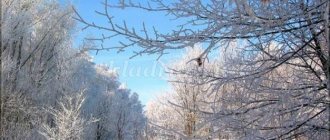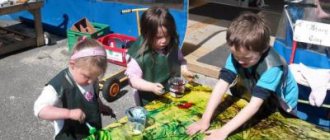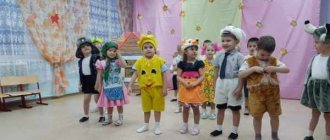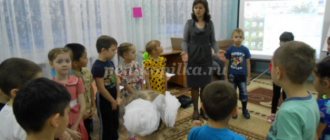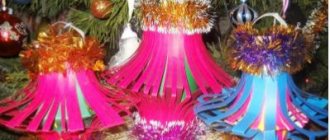Summary of a comprehensive lesson in the second junior group “Winter has come”
Summary of a comprehensive lesson in the second junior group “Winter has come” Goal: to activate the cognitive, speech and visual activity of children; to form a generalized idea of the life of birds in winter.
Software tasks:
- consolidate knowledge about winter;
- consolidate knowledge about clothing items;
— activate the dictionary;
-develop a sense of kindness, a desire to take care of birds.
Materials: pictures with items of clothing (tights, socks, pants, hat, scarf, fur coat, mittens and boots), cards and illustrations depicting a dove, titmouse, sparrow, magpie; wood drawing, snowflakes, glue, brushes, napkins.
Progress of the lesson
Educator: Guys, did you notice on the way to kindergarten how cold it was outside? And why?
Children: Because it’s winter outside.
Educator: that’s right, what should you wear to keep from freezing? Children: clothes
Educator: Who will name her for me? Name... items of clothing and show them (they show, explain which parts of the body to put them on).
Educator: Well done! We won’t freeze if we put on warm clothes, and if we start to freeze, we’ll warm ourselves up:
Physical school
We'll warm up a little, We'll clap our hands. Clap, clap, clap. We put on mittens, We are not afraid of the blizzard. Yes Yes Yes. We'll warm our feet too, We'll jump soon, Yes, yes, yes. We'll warm our feet too, We'll jump soon. Jump, jump, jump. The frost and I became friends, Like snowflakes swirling. So so so.
Educator: Why is it white outside in winter? What's on the ground?
Children: There is snow on the ground.
Educator: Right, what kind of snow?
Children: Light, cold, white.
Educator: And when it snows a lot, what is this phenomenon called?
Children: Snowfall
Educator: And if a strong wind blows during a snowfall, what will happen?
Children: Vyuga
Game “Snowflakes and the Wind” (Children gather in a circle and join hands. At the adult’s signal: “The wind blew strong, strong. Scatter, snowflakes!” - they scatter in different directions, spread their arms to the sides, sway, spin. The adult says: "The wind has died down! Come back, snowflakes, to the circle!" Children run into a circle and join hands.)
Educator: Look carefully, what else do the children do in the winter in the picture? What is the boy doing? What else can you ride in winter?
Zimushka - Winter comes to visit us every year. If you look out the window, you can see how white it is. If you go outside, you can feel how cold it is.
Although it is cold outside in winter, you can come up with many different games, fun and entertainment. What can you do when it snows? (Look at snowflakes on your fur coat, catch snowflakes, shovel snow, clean paths, etc.) What can you do when the snow is wet? (Play snowballs, build a fort, fences, sculpt a snowman, etc.) What can you do when it’s cold and you need to warm up? (Run along the paths, ride each other on a sled, go skiing, etc.) What games can you come up with with snow? (Bake pies, build houses,
Educator: Do you remember who flies to our site?
Educator: Why do many birds fly to warmer climes?
Children: Because they are afraid of the cold, and they cannot get enough food for themselves.
Educator: What is the name in one word for birds that fly away?
Children: Migratory.
Educator: Guys, do all the birds fly away?
Children: No, not all, some remain.
Educator: Look what a beautiful bird it is - a magpie. Repeat.
Children: Magpie.
Educator: What kind of breast does a magpie have? What is it also called?
Educator: Another bird flew to us, a titmouse. Repeat.
Children: Titmouse.
Educator: What kind of breast does a titmouse have?
Children: Yellow.
Educator: And this is a big bird, a dove. What dove? The dove is also called the sizar. Repeat
Children: Sisari.
Educator: Guys, it’s very cold outside, the wind is blowing. Our birds want to eat. Remember what we fed the birds on our walk?
Children: Bread crumbs, seeds.
Bottom line
-Did you like the lesson? What new have you learned? And now I suggest you decorate our tree with snowflakes so that it doesn’t feel cold and lonely.
(collective activity of children)
